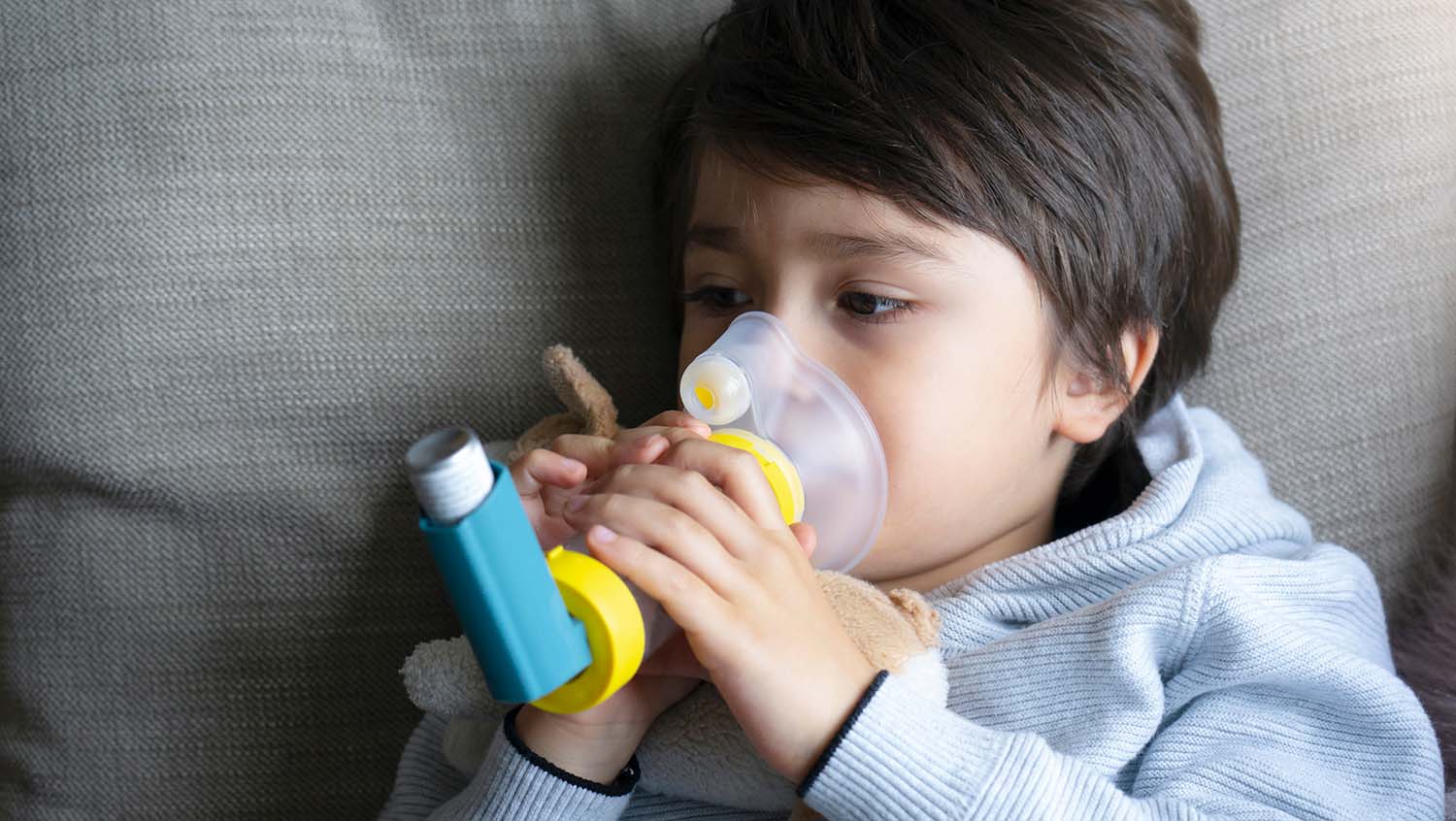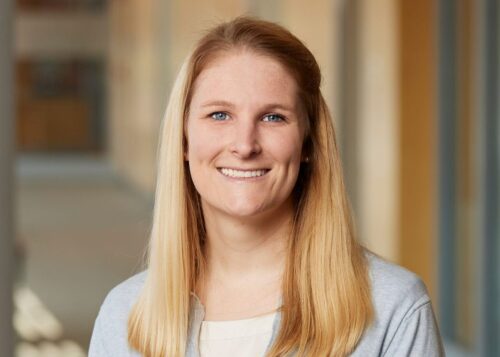How BMC's Pediatric Asthma Program Works to Keep Children Out of Emergency Rooms
November 1, 2021
By David Limm

Getty Images
Guided by a evidence-based system of care, the team of specialists aims to leave no child with asthma behind.
If the staff members at Boston Medical Center’s Pediatric Asthma Program have their way, asthma will be on the minds of every doctor, nurse, and medical assistant throughout the hospital’s pediatric primary care practice, where it’s based. Whether it’s for a rash, a cough, or a routine inoculation, the program’s goal is to use every visit by a patient with asthma as a chance to screen for symptoms.
This fall, Boston’s K-12 students returned to full-time, in-person learning. Screening may now be as important as ever for the children affected by asthma, the leading cause of school absenteeism due to chronic illness. Pandemic-driven closures and changes to behavior, lifestyle, and environment appear to have led to drops in severe asthma incidents, but parents and specialists worry about what the return to school could bring as COVID-19 restrictions continue to lift.
The team leading BMC’s Pediatric Asthma Program, which delivers care through a lens of health equity, is committed to preventing children from having an asthma attack that leads to an emergency department (ED) visit or hospitalization. The majority of its patients live in neighborhoods such as Dorchester, Roxbury, and Mattapan, where rates of ED visits for asthma among 3- to 5-year-olds are the highest in the city.
North Dorchester and Roxbury have among the highest percentage of families with children living in poverty in the city, according to the Boston Public Health Commission, whose 2013 survey also found that Boston’s Black and Latinx children were diagnosed with asthma at twice the rate of white children.
Out of the approximate 13,000 children in BMC’s pediatric primary care practice, between 15% and 20% are diagnosed with asthma, according to Robyn Cohen, MD, MPH director and founder of the Pediatric Asthma Program, who is also division chief of the Pediatric Pulmonary & Allergy Clinic. In 2017, before the asthma program’s existence, about half of BMC’s pediatric primary care patients with asthma had been to the emergency department or hospitalized with an acute attack, according to Medicaid data, she says.
“We were missing opportunities to identify kids whose asthma was not well controlled before they went to the emergency room,” says Cohen.
Leave no child with asthma behind
Trying to keep kids from falling through the cracks can be a challenge. From the start, leave no child with asthma behind was a driving principle, explains Cohen.
In 2017, Cohen and a former asthma program coordinator, Margaret Laws, created an asthma care checklist inspired by a book by Atul Gawande, surgeon and writer for The New Yorker, who makes the case for using simple lists to execute complex and critical procedures, as in surgeries. Their asthma checklist for providing consistent, effective care to the high-risk patients they were serving was the seed that grew into a set of initiatives that is now BMC’s pediatric asthma program.

<em>Robyn Cohen, MD, MPH is director of BMC’s Pediatric Asthma Program and also division chief of the Pediatric Pulmonary & Allergy Clinic. (Boston Medical Center)</em>
The asthma program uses a system of care that combines those initiatives—a powerful data-mining approach, an ambitious screening effort, and an intensive outreach program for high-risk patients—with an enterprising pharmacy. The crux of the system, Cohen says, is an asthma patient registry that allows staff to systematically provide care. Using data compiled in real time from electronic medical records, staff generate reports that can tell them which patients need to be screened, which utilize acute care, or which haven’t had a follow-up visit in some time.
“We’re constantly mining the registry,” says Cohen. “Who needs a flu shot? Who is overdue for a follow-up visit? Who spent all last fall in the emergency room?”
Children in the registry are identified as needing an asthma symptom screening every time they come for a primary care visit. They are given a brief questionnaire, which exists in multiple languages, called ACT, for asthma control test. Patients under age 5 take TRACK, which stands for test for respiratory and asthma control in kids. A low score sends up a red flag alerting the provider or nurse to the fact that a child’s asthma is not well controlled.
From there, a nurse or provider investigates: Does the patient need more education for using medication? Do they need their treatment plan adjusted? Are there triggers in the home that need to be addressed?
“Asthma is all about triggers,” says Giovannie Bejin, MSN, CPNP-PC a nurse practitioner for the program, who performs intensive outreach to patients and families. Part of her work involves calling families to identify irritants or substances, like pests, allergens, or pets. “I always ask, ‘Are there any smokers in the home?'”
But families can only control so much about their environment. Bejin says she talks to many who live in subsidized housing or shelters, where second-hand smoke is hard to escape. Program staffers often write letters to landlords or shelters, advocating for families, requesting relocation to non-smoking units, or removing carpet flooring, or reporting mold and mildew. In Dorchester and Roxbury, for example, old homes, air pollution, and poverty create a harmful atmosphere. Psychosocial stressors abound, making it tougher to control one’s asthma.
A common confusion: Which inhaler should I use?
One variable that families do have control over is medication—but it’s also the most common source of confusion. Although the program provides an asthma action plan, Bejin says most families she speaks to have trouble using it properly at first.
“My job is to really break things down, make sure they understand how to give the medication, when to give the medication, what to do when the child has symptoms, worsening problems, and, of course, answer all their questions,” says Bejin.
“I review the information every month because I know with repetition, they’ll get it. It will stay there. Some of it will stay there.”
Just knowing which inhaler to use is a jumble of confusion. The quick-relief or “rescue” inhaler is made by numerous brands and comes in a handful of colors.
“A family doesn’t always know which [inhaler] they will get,” explains Cohen. “You go to the pharmacy to refill your albuterol, and this month you might get a blue one, and last month you might have gotten a yellow one.”
Having a drawer full of multi-hued inhalers each with distinct purposes complicates home asthma management, particularly for families with language and literacy barriers.
Complicating matters, Medicaid or private insurers occasionally make formulary changes to their asthma medications lists, affecting what’s covered. Recently, two major overhauls happened in the span of a year, leading to multiple changes in asthma treatment plans. To prevent parents from leaving the pharmacy empty-handed or with medication that’s not covered, Cohen says clinic staffers spent months contacting patients about the changes.
A close partnership with BMC’s pharmacy has been a boon for families. Cohen and Bejin say that its dynamic medication management is novel among pharmacies. Constant communication occurs between the medical home, the pharmacy liaison, and the families. The parents also appreciate that medication is delivered to their home.
“Families love that, oh my goodness,” says Bejin. “I just say, ‘I can connect you to a pharmacy. They can mail your prescription to you,’ and they’re a lot more open to talk to me about asthma.”
“I don’t know other places who have such proactive pharmacies,” adds Cohen. “And this has been phenomenal, especially in a pandemic, when families don’t want to stand inside Walgreens and wait in a 30-minute line inside a public place.
Preventing an asthma-related ‘fire’ altogether
Since 2018, the year the asthma program’s pieces all came together, there have been signs that the work is paying off.
Though there are few quality measures for asthma control, BMC has excelled in the most common benchmark: asthma medication ratio (AMR). The AMR is an indicator of patients using preventive medication rather than emergency rescue medication. Over the past two years, it had the highest AMR among the 12 primary care practices in the Boston Accountable Care Organization, a community health system providing coordinated care to Massachusetts Medicaid patients.
The equity-focused program has also seen promising reductions in the number of patients treated for asthma attacks. Out of 32 children who in the fall of 2018 had at least two ED visits, a hospitalization, or a steroid burst, only 10 received acute care one year later, according to the program. Of the 18 high-risk children who came in to the ED for acute asthma care in the winter of 2019, only six needed it the following winter.
Although the COVID-19 pandemic forced the program to put its asthma screening initiative on hold for the majority of 2020, the clinic team is working hard to recover its pre-pandemic level of screening about two-thirds of eligible patients.
As Bejin says, parents do not want to talk about asthma when the reason they’re at the hospital is not asthma—they’re busy putting out a different fire. So, armed with real-time patient data, an active screening effort, a nurse-led family outreach program, and a proactive pharmacy, what BMC’s Pediatric Asthma Program hopes to do is prevent an asthma-related fire altogether, so families can focus on other urgent matters.
“Kids are going to school. Parents have a lot less stress,” says Bejin. “Once you know how to administer this medication, how to stay away from triggers, how to control symptoms, you do not need the emergency room. You feel good and confident. You feel like you can take care of your child with what you know.”
BMC’s Pediatric Asthma Program’s team also includes: medical assistant Sara Hanna, BS; nurses Elizabeth Robinson, MSN, RN and Jude Teleau, BSN, RN; pediatrician Rachel Sagor, MD; and program coordinator Leah Shafer, MPP, MBA.


